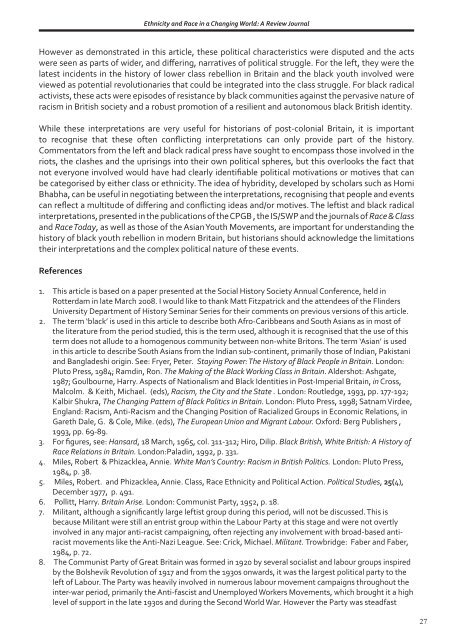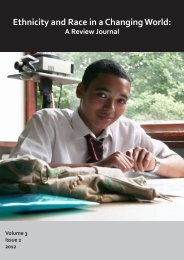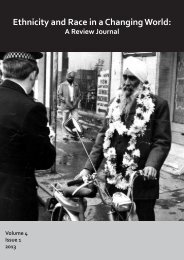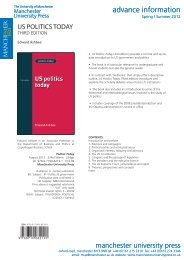Ethnicity and Race in a Changing World
Volume 2, Issue 1, 2010 - Manchester University Press
Volume 2, Issue 1, 2010 - Manchester University Press
- No tags were found...
Create successful ePaper yourself
Turn your PDF publications into a flip-book with our unique Google optimized e-Paper software.
<strong>Ethnicity</strong> <strong>and</strong> <strong>Race</strong> <strong>in</strong> a Chang<strong>in</strong>g <strong>World</strong>: A Review JournalHowever as demonstrated <strong>in</strong> this article, these political characteristics were disputed <strong>and</strong> the actswere seen as parts of wider, <strong>and</strong> differ<strong>in</strong>g, narratives of political struggle. For the left, they were thelatest <strong>in</strong>cidents <strong>in</strong> the history of lower class rebellion <strong>in</strong> Brita<strong>in</strong> <strong>and</strong> the black youth <strong>in</strong>volved wereviewed as potential revolutionaries that could be <strong>in</strong>tegrated <strong>in</strong>to the class struggle. For black radicalactivists, these acts were episodes of resistance by black communities aga<strong>in</strong>st the pervasive nature ofracism <strong>in</strong> British society <strong>and</strong> a robust promotion of a resilient <strong>and</strong> autonomous black British identity.While these <strong>in</strong>terpretations are very useful for historians of post-colonial Brita<strong>in</strong>, it is importantto recognise that these often conflict<strong>in</strong>g <strong>in</strong>terpretations can only provide part of the history.Commentators from the left <strong>and</strong> black radical press have sought to encompass those <strong>in</strong>volved <strong>in</strong> theriots, the clashes <strong>and</strong> the upris<strong>in</strong>gs <strong>in</strong>to their own political spheres, but this overlooks the fact thatnot everyone <strong>in</strong>volved would have had clearly identifiable political motivations or motives that canbe categorised by either class or ethnicity. The idea of hybridity, developed by scholars such as HomiBhabha, can be useful <strong>in</strong> negotiat<strong>in</strong>g between the <strong>in</strong>terpretations, recognis<strong>in</strong>g that people <strong>and</strong> eventscan reflect a multitude of differ<strong>in</strong>g <strong>and</strong> conflict<strong>in</strong>g ideas <strong>and</strong>/or motives. The leftist <strong>and</strong> black radical<strong>in</strong>terpretations, presented <strong>in</strong> the publications of the CPGB , the IS/SWP <strong>and</strong> the journals of <strong>Race</strong> & Class<strong>and</strong> <strong>Race</strong> Today, as well as those of the Asian Youth Movements, are important for underst<strong>and</strong><strong>in</strong>g thehistory of black youth rebellion <strong>in</strong> modern Brita<strong>in</strong>, but historians should acknowledge the limitationstheir <strong>in</strong>terpretations <strong>and</strong> the complex political nature of these events.References1. This article is based on a paper presented at the Social History Society Annual Conference, held <strong>in</strong>Rotterdam <strong>in</strong> late March 2008. I would like to thank Matt Fitzpatrick <strong>and</strong> the attendees of the Fl<strong>in</strong>dersUniversity Department of History Sem<strong>in</strong>ar Series for their comments on previous versions of this article.2. The term ‘black’ is used <strong>in</strong> this article to describe both Afro-Caribbeans <strong>and</strong> South Asians as <strong>in</strong> most ofthe literature from the period studied, this is the term used, although it is recognised that the use of thisterm does not allude to a homogenous community between non-white Britons. The term ‘Asian’ is used<strong>in</strong> this article to describe South Asians from the Indian sub-cont<strong>in</strong>ent, primarily those of Indian, Pakistani<strong>and</strong> Bangladeshi orig<strong>in</strong>. See: Fryer, Peter. Stay<strong>in</strong>g Power: The History of Black People <strong>in</strong> Brita<strong>in</strong>. London:Pluto Press, 1984; Ramd<strong>in</strong>, Ron. The Mak<strong>in</strong>g of the Black Work<strong>in</strong>g Class <strong>in</strong> Brita<strong>in</strong>. Aldershot: Ashgate,1987; Goulbourne, Harry. Aspects of Nationalism <strong>and</strong> Black Identities <strong>in</strong> Post-Imperial Brita<strong>in</strong>, <strong>in</strong> Cross,Malcolm. & Keith, Michael. (eds), Racism, the City <strong>and</strong> the State . London: Routledge, 1993, pp. 177-192;Kalbir Shukra, The Chang<strong>in</strong>g Pattern of Black Politics <strong>in</strong> Brita<strong>in</strong>. London: Pluto Press, 1998; Satnam Virdee,Engl<strong>and</strong>: Racism, Anti-Racism <strong>and</strong> the Chang<strong>in</strong>g Position of Racialized Groups <strong>in</strong> Economic Relations, <strong>in</strong>Gareth Dale, G. & Cole, Mike. (eds), The European Union <strong>and</strong> Migrant Labour. Oxford: Berg Publishers ,1993, pp. 69-89.3. For figures, see: Hansard, 18 March, 1965, col. 311-312; Hiro, Dilip. Black British, White British: A History of<strong>Race</strong> Relations <strong>in</strong> Brita<strong>in</strong>. London:Palad<strong>in</strong>, 1992, p. 331.4. Miles, Robert & Phizacklea, Annie. White Man’s Country: Racism <strong>in</strong> British Politics. London: Pluto Press,1984, p. 38.5. Miles, Robert. <strong>and</strong> Phizacklea, Annie. Class, <strong>Race</strong> <strong>Ethnicity</strong> <strong>and</strong> Political Action. Political Studies, 25(4),December 1977, p. 491.6. Pollitt, Harry. Brita<strong>in</strong> Arise. London: Communist Party, 1952, p. 18.7. Militant, although a significantly large leftist group dur<strong>in</strong>g this period, will not be discussed. This isbecause Militant were still an entrist group with<strong>in</strong> the Labour Party at this stage <strong>and</strong> were not overtly<strong>in</strong>volved <strong>in</strong> any major anti-racist campaign<strong>in</strong>g, often reject<strong>in</strong>g any <strong>in</strong>volvement with broad-based antiracistmovements like the Anti-Nazi League. See: Crick, Michael. Militant. Trowbridge: Faber <strong>and</strong> Faber,1984, p. 72.8. The Communist Party of Great Brita<strong>in</strong> was formed <strong>in</strong> 1920 by several socialist <strong>and</strong> labour groups <strong>in</strong>spiredby the Bolshevik Revolution of 1917 <strong>and</strong> from the 1930s onwards, it was the largest political party to theleft of Labour. The Party was heavily <strong>in</strong>volved <strong>in</strong> numerous labour movement campaigns throughout the<strong>in</strong>ter-war period, primarily the Anti-fascist <strong>and</strong> Unemployed Workers Movements, which brought it a highlevel of support <strong>in</strong> the late 1930s <strong>and</strong> dur<strong>in</strong>g the Second <strong>World</strong> War. However the Party was steadfast27






